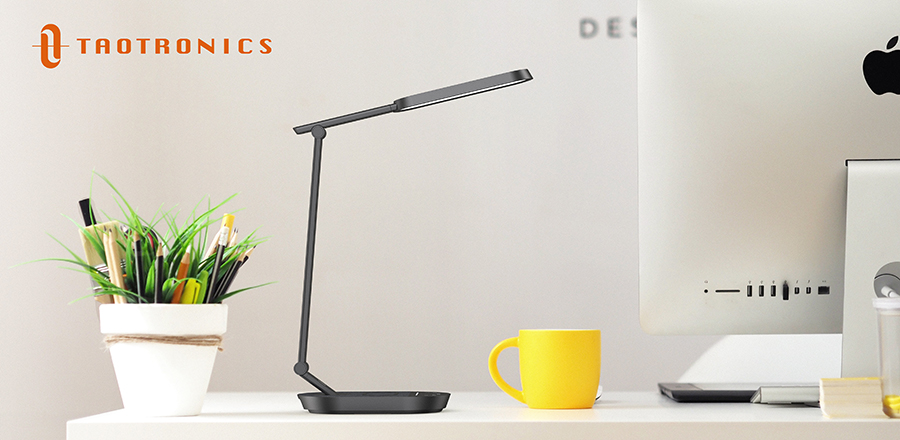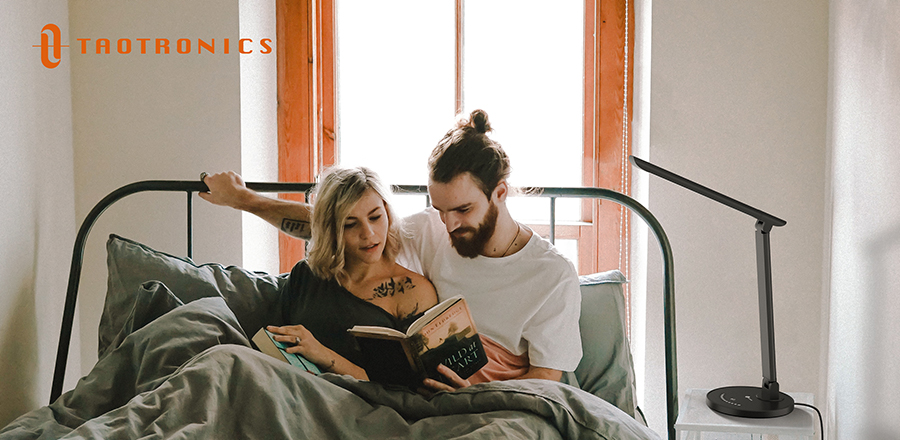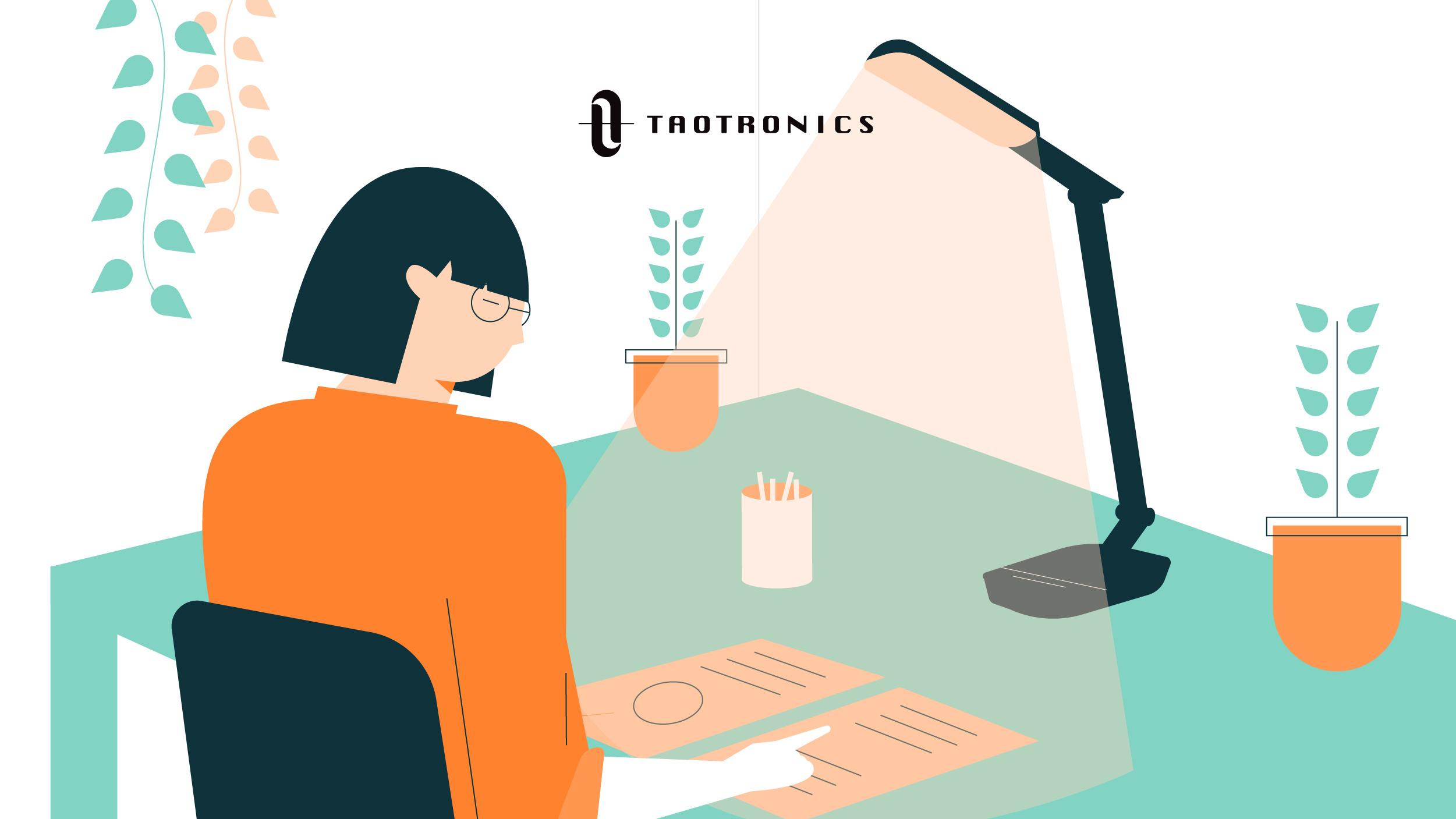There’s nothing better than relaxing on a sunny day and reading your favorite book. But what if you’re indoors and need the best desk lamp for studying? How can you find the best reading lamp that will protect your eyes?
Buying a lamp might seem an easy task. Then you realize that lamp and lighting discussions need their own dictionary. Then, once you have looked at more than five lamps (because you have to compare!) they all start to blend into one.
Don’t worry! If you have not heard of lumens, color temperature, or kelvin ranges, then there’s no need to feel overwhelmed!
At TaoTronics, we understand that finding the right lighting makes all the difference when you are reading or studying. That’s why we have put together this guide. You’ll find all of the best lighting tips for reading as well as recommendations for the best desk lamp for studying.
The Importance of Good Lighting for Reading and Studying

You might have heard that natural light is the best for reading in. And often, this is correct.
It is only in the past 100 years or so that artificial lighting has become widely available. Before Alexander Lodygin created the incandescent lightbulb in 1874, which took a lot longer to become commonplace, people would read by sunshine, candle, and so on.
However, these lights can be quite dim. They are also only available at certain times and have a short time limit of use (daylight/the candle burning out.) Even gas lighting had its downsides – it could be dangerous, for one!
As lighting has developed, we have come to understand that the light you read by can have a direct impact on how you feel, and how your eyes are affected. This is like Apple putting the blue light filter on their iPhones. Blue light keeps your brain stimulated, making it harder for you to sleep at night.
If we study or read in dim lighting, what happens?
One of our best lighting tips for reading is simple: don’t read in a dim light. Whether this is natural or a poorly lit lamp, you should try and avoid putting yourself in this situation.
This is for two main reasons:
- Dim lighting can harm your eyes by causing Myopia (near sightedness)
If you can see close up but words in the distance are fuzzy, you likely suffer from Myopia. This is a common eyesight problem and is easily solved by wearing the correct glasses or contact lenses.
Some studies have shown that not having the best reading lamp and letting yourself read in a dim light can increase the chances of myopia. You have probably felt it yourself after reading in a dim light as your pupils have to dilate further to be able to read the words. When you look up, items and text in the distance might look blurry for a little while.
For some people, this strain might not cause myopia and instead give them headaches. For these people, reading in a stronger light is always recommended.
- If you read in a dim light, you have a lower learning efficiency
Studies have shown that the correct lighting can increase your grades. This is because dim lighting can lower the brains ability to process and retain data and can increase feelings of anxiety.
Similarly, anyone who has taken an exam is aware that harsh bright lighting can prevent you from focusing. When a bright light reflects off the page into your eye it is very distracting and can potentially harm your eye itself.
For optimum results, then, you need to work out your optimal brightness settings and find the best desk lamp for studying.
If we study or read in good lighting, what are the benefits?
So what happens if you read in good to optimal lighting?
- Eye strain is reduced
Your pupils no longer have to dilate to get as much light as possible. This reduces your chances of eye strain.
- It creates a calm and efficient learning environment
When you add the correct lighting to a room, you reduce the level of external distractions. Your brain can focus on the data it is trying to take in. This means you are more likely to remember what you are reading about.
Two Main Elements of the Best Reading Lamp

To understand the best things to look for in a reading lamp, you need to know about two concepts.
- Color Temperature: applies to LED rather than filament bulbs. It is measured in Kelvin (K) and is compared to the color a piece of steel glows when heated. See a more detailed description below.
- Brightness: measured in Lumens (lm), which tell you the power of the light. Low energy LEDs will be able to emit a brighter light using less power, so will have more Lumens per Watt. Around 450lm with a 6 to 9-Watt LED bulb is a good all-round brightness.
What is the Right Color Temperature for Studying and Reading?
There are a huge range of color temperatures available!
Less than 2000K
Gives off a dim light, similar to candlelight. It is best for low-lit areas and rooms that need an ambient glow.
2000K-3000K
With a soft white glow that some consider more yellow, this light is great for the outdoors as well as indoors. Often you will find it in living rooms, dining rooms, and bedrooms.
3100K-4500K
This is most commonly found in kitchens, offices and areas of “task lighting.” The white light is much brighter.
4600K-6500K
Very similar to daylight, offering a blue-white glow. Great for workplaces and areas that need bright illumination.
6500K and Over
Most likely to be found in commercial locations, this color temperature emits a bright, blue light.
We look into which is the best lighting for reading and studying below.
The Best Lighting Tips for Reading and Studying
We have already suggested that you should not read in dim light if you are trying to study or take in more information. But we have a few more tricks to tell you about!
A tip you should keep in mind is that a bulb that is brighter, with a cooler white to natural daylight range is best for reading and study. This is the equivalent of 4000K to 6500K. You will find yourself feeling more awake and ready to take in information.
Also, make sure you know which lamp design will work best for your work and room. A longer LED lamp with bulbs will disperse the light more evenly across a bigger area. A small spotlight will keep the light in one specific area, meaning you might have to move your book or equipment to read and study.
More Tips for Choosing the Best Desk Lamp for Studying or Reading
Some features to consider before you buy your lamp include:
Flexibility and Design
Modern lamps will have the option of a flexible or rotating arm and head, making it easy for you to customize your lighting. A more traditional lamp, the type you often see in living rooms with a lampshade, will only cast light in the area it is placed. For most people, a modern and portable lamp from the TaoTronics range is preferable.
Dimmability and Color Temperature
Being able to dim your lamp is a useful feature, as you might only need a small amount of extra light in the early evening. If your lamp was on at full brightness, the excess could cause harm to your eyes. Similarly, choosing the correct color temperature for your environment will make a difference to your environment and use of the lamp.
Brightness and Glare Protection
As we suggested above, you should ideally find a lamp with a bulb at 4000K to 6500K. For general reading andstudying, look for around 450lm from 6-9 watts. One that has glare protection features, like this TaoTronics Eye-Caring Desk Lamp (TT-DL13), will also help you look after your eyes if you are studying for long periods of time.
Energy Consumption and Lifespan
You need a lamp that will last for up to 50,000 hours, so that you only have to change the bulb once every 6 years or so! This will mean an extended lifespan – not only better for your wallet, but for the environment.
Available Space and Price
The practicalities of buying a lamp. Consider where the lamp will be placed in your room before you buy; there is no point buying a floor lamp if you only have space on your desk. Also, prices can vary from tens to hundreds of dollars, so think of a price you are willing to spend and the features you need in that price range before you purchase.
Conclusion
Buying a lamp involves more than just finding one you like the look of. Especially if you want to find the best desk lamp for studying, you should focus on buying lighting that is in the 4000K-6500K range and is able to be dimmed. You should also look for a well-designed lamp that has a long lifespan. Not only will you be illuminating your life, but you will be protecting your eyes from unnecessary damage. What more could you ask for!
TaoTronics desk lamps offer all these features (and more!) at affordable prices. Check them out today!
- What is White Noise? Learn How a Sound Machine can Send You and Your Baby to Sleep - March 12, 2021
- Get A Phone Ring Light to Take the Best Selfies and Videos! - October 30, 2020
- How to Choose the Best Lamp to Brighten Your Home Office - August 21, 2020
